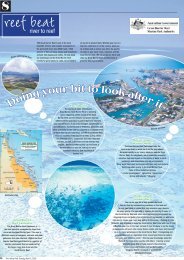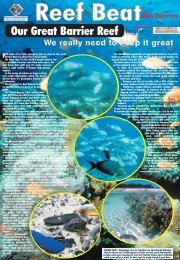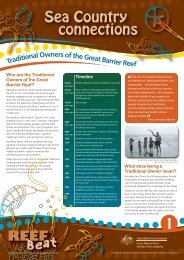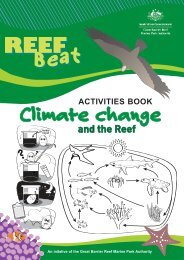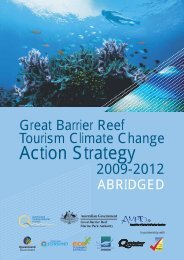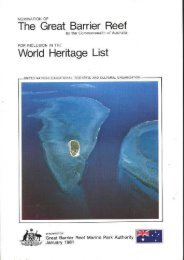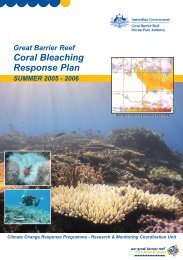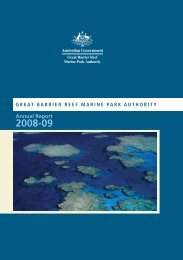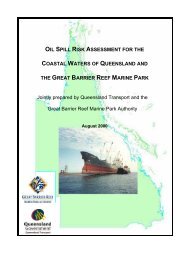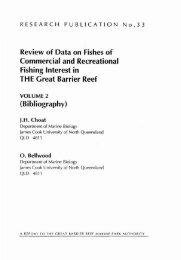Great Barrier Reef Outlook Report 2009 â In Brief
Great Barrier Reef Outlook Report 2009 â In Brief
Great Barrier Reef Outlook Report 2009 â In Brief
- No tags were found...
Create successful ePaper yourself
Turn your PDF publications into a flip-book with our unique Google optimized e-Paper software.
6EXISTING PROTECTIONAND MANAGEMENTBoth the Australian and Queensland Governments havedirect legislative responsibilities within the <strong>Great</strong> <strong>Barrier</strong><strong>Reef</strong> Region. A joint management arrangement betweenthe Australian and Queensland Governments ensuresintegrated field management of the two marine protectedareas, plus protected areas on the islands within the Region.<strong>In</strong> addition, many other government agencies, stakeholdersand community members contribute to protection andmanagement of the <strong>Great</strong> <strong>Barrier</strong> <strong>Reef</strong>, both on the waterand in the catchment.Advisory Committees and <strong>Reef</strong> Advisory Committees, plusthe <strong>Outlook</strong> Forum. The assessment examined 12 broadmanagement topics and the full report is available online atwww.gbrmpa.gov.au.The independent assessors found that managementeffectiveness challenges are evident for those managementtopics that are broad in scale and complex socially,biophysically and jurisdictionally (for example climatechange, coastal development, water quality and fishing).Effectiveness is strongest on issues that are limited in scale,intensity or complexity (for example defence and scientificresearch). Their key findings were:Many biodiversity protection measures, for examplezoning plans, are making a difference, but there isno overarching framework to guide and coordinatemanagement actions.Design/PlanningContextIs the topicunderstood?Marine Parks eld management is a joint operation by Australian andQueensland Government agencies.A broad assessment of the effectiveness of the managementactivities currently undertaken by all these contributors is animportant component in determining the major risks thatremain for the <strong>Great</strong> <strong>Barrier</strong> <strong>Reef</strong> and predicting its outlook.<strong>In</strong> order to ensure independence, the <strong>Great</strong> <strong>Barrier</strong> <strong>Reef</strong>Marine Park Authority commissioned two external assessorsto undertake the assessment, including all activities thatcontribute to protection and management of the <strong>Great</strong><strong>Barrier</strong> <strong>Reef</strong>.Management actions that take place both inside and outsidethe <strong>Great</strong> <strong>Barrier</strong> <strong>Reef</strong> Region were examined to the extentthat they influence the protection and management of the<strong>Great</strong> <strong>Barrier</strong> <strong>Reef</strong> ecosystem. The assessment followed theframework for evaluating management of protected areasdeveloped by the <strong>In</strong>ternational Union for the Conservationof Nature and Natural Resources (IUCN) World Commissionon Protected Areas, based on a management cycle in whichmanagement is continuously evaluated and refined (figure6.1).Detailed information on current management was collatedby both Australian and Queensland Government agenciesand provided to the assessors. The assessors were alsoprovided with advice on management effectiveness fromthe <strong>Great</strong> <strong>Barrier</strong> <strong>Reef</strong> Marine Park Authority’s Local MarineDeliveryFigure 6.1OutcomesIs managementmaking a difference?OutputsAre plans beingfollowedand outputsdelivered?EvaluationProcessHow did wego aboutmanagement?PlanningAre thereclear goalsand adequateplans and policies?<strong>In</strong>putsAre there sufficientresources?Adequacy/AppropriatenessThe management cycleEffective management is a closed loop where issues areconsidered, plans are made, resources are expended, properprocesses are followed and products and services are delivered,all leading to outcomes that address the issues. An assessment ofeach of the steps in this management cycle provides a completepicture of management effectiveness. For example, assessing onlyoutcomes may indicate a particular objective has been achievedbut leaves it unclear as to whether this was due to good luck orgood management. Conversely, it may be hard to understand whydesired outcomes were not achieved unless all management stepsare examined. (Adapted from Hockings et al. 2006 23 )Effects of predation on prey species,<strong>Great</strong> <strong>Barrier</strong> <strong>Reef</strong>3513GREAT BARRIER REEF OUTLOOK REPORT <strong>2009</strong> IN BRIEF



